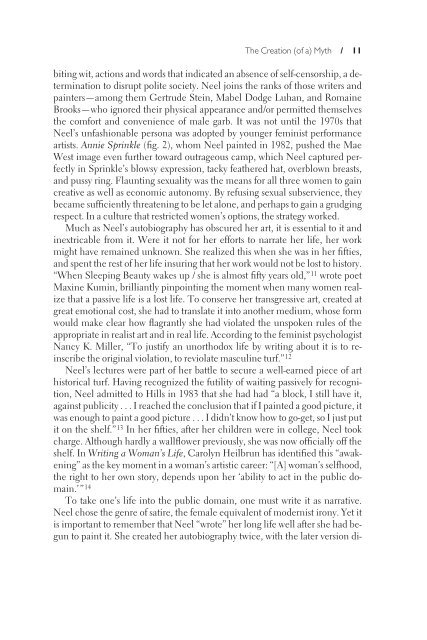i-xxii Front matter.qxd - Brandeis Institutional Repository
i-xxii Front matter.qxd - Brandeis Institutional Repository
i-xxii Front matter.qxd - Brandeis Institutional Repository
Create successful ePaper yourself
Turn your PDF publications into a flip-book with our unique Google optimized e-Paper software.
The Creation (of a) Myth / 11biting wit, actions and words that indicated an absence of self-censorship, a determinationto disrupt polite society. Neel joins the ranks of those writers andpainters—among them Gertrude Stein, Mabel Dodge Luhan, and RomaineBrooks—who ignored their physical appearance and/or permitted themselvesthe comfort and convenience of male garb. It was not until the 1970s thatNeel’s unfashionable persona was adopted by younger feminist performanceartists. Annie Sprinkle (ƒg. 2), whom Neel painted in 1982, pushed the MaeWest image even further toward outrageous camp, which Neel captured perfectlyin Sprinkle’s blowsy expression, tacky feathered hat, overblown breasts,and pussy ring. Flaunting sexuality was the means for all three women to gaincreative as well as economic autonomy. By refusing sexual subservience, theybecame sufƒciently threatening to be let alone, and perhaps to gain a grudgingrespect. In a culture that restricted women’s options, the strategy worked.Much as Neel’s autobiography has obscured her art, it is essential to it andinextricable from it. Were it not for her efforts to narrate her life, her workmight have remained unknown. She realized this when she was in her ƒfties,and spent the rest of her life insuring that her work would not be lost to history.“When Sleeping Beauty wakes up / she is almost ƒfty years old,” 11 wrote poetMaxine Kumin, brilliantly pinpointing the moment when many women realizethat a passive life is a lost life. To conserve her transgressive art, created atgreat emotional cost, she had to translate it into another medium, whose formwould make clear how „agrantly she had violated the unspoken rules of theappropriate in realist art and in real life. According to the feminist psychologistNancy K. Miller, “To justify an unorthodox life by writing about it is to reinscribethe original violation, to reviolate masculine turf.” 12Neel’s lectures were part of her battle to secure a well-earned piece of arthistorical turf. Having recognized the futility of waiting passively for recognition,Neel admitted to Hills in 1983 that she had had “a block, I still have it,against publicity . . . I reached the conclusion that if I painted a good picture, itwas enough to paint a good picture . . . I didn’t know how to go-get, so I just putit on the shelf.” 13 In her ƒfties, after her children were in college, Neel tookcharge. Although hardly a wall„ower previously, she was now ofƒcially off theshelf. In Writing a Woman’s Life, Carolyn Heilbrun has identiƒed this “awakening”as the key moment in a woman’s artistic career: “[A] woman’s selfhood,the right to her own story, depends upon her ‘ability to act in the public domain.’”14To take one’s life into the public domain, one must write it as narrative.Neel chose the genre of satire, the female equivalent of modernist irony. Yet itis important to remember that Neel “wrote” her long life well after she had begunto paint it. She created her autobiography twice, with the later version di-
















